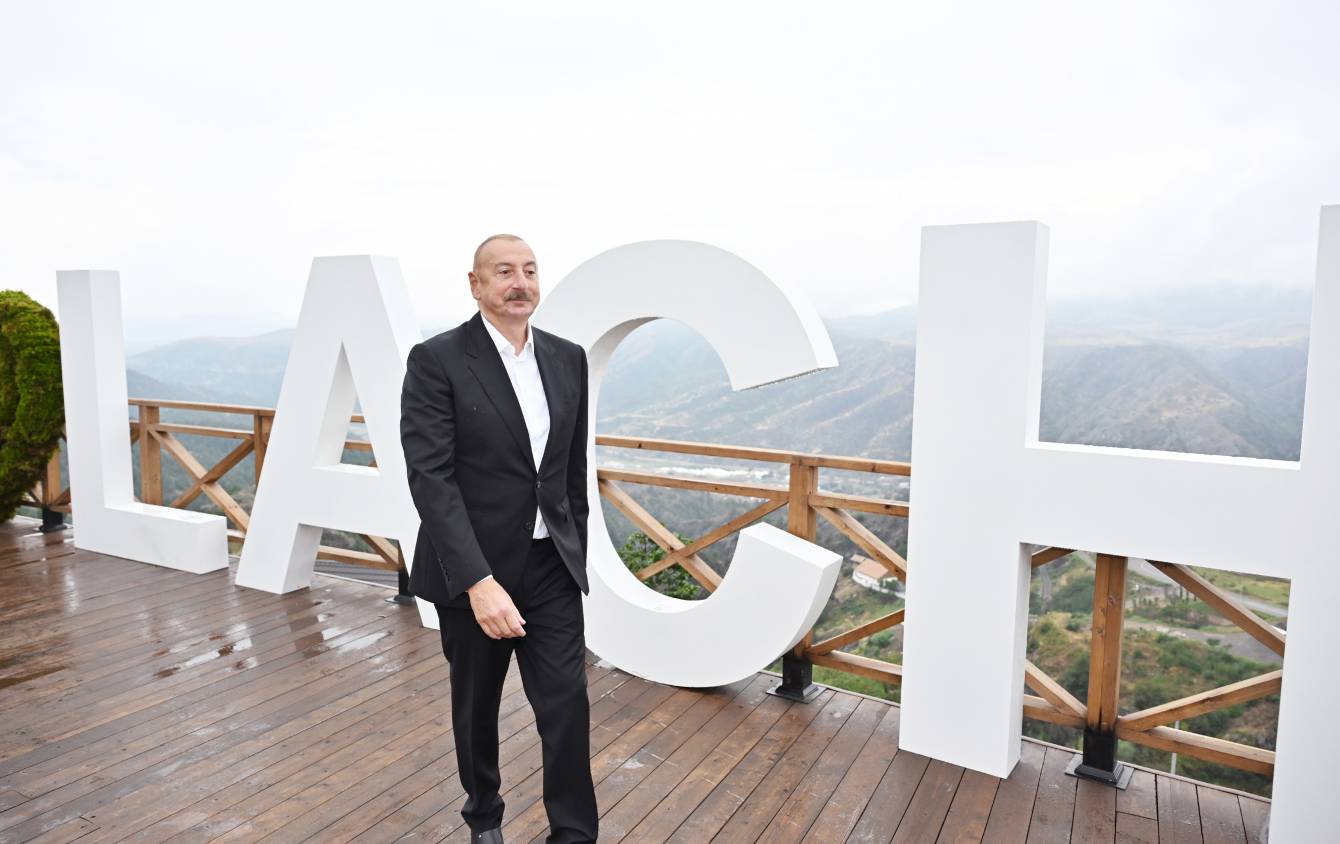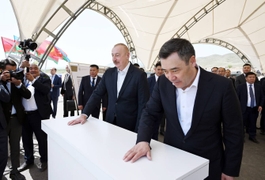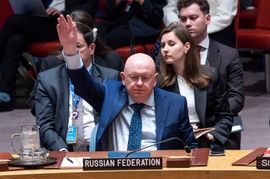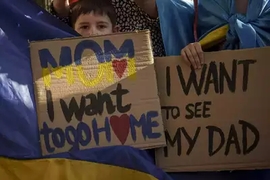Three years ago, on December 1, Lachin district has been returned to Azerbaijan after 28 years of illegal occupation by Armenia. The restoration of Azerbaijan’s sovereignty in the district followed a Russian-brokered statement that sealed the victory of Azerbaijan over Armenia in the Second Karabakh War.
In a televised address to the nation on December 1, 2020, Azerbaijani President Ilham Aliyev hailed the restoration of control over the areas as a historic achievement.
"Lachin district is one of our biggest districts. Lachin district will play an important part in the future economic development of Azerbaijan," said President Aliyev, adding that the return of the people to Lachin, who were forced to abandon their homes as a result of Armenia's occupation, is one of the main priorities.
"When Lachin was occupied, just over 50,000 people lived in it. Today the population of the Lachin district has reached 80,000 people. Of course, one of our main goals will be to return the residents of Lachin there as soon as possible."
Lachin, one of the largest districts in Azerbaijan spanning an area of 1,800 square kilometers, was occupied by Armenia's armed forces on May 18, 1992, connecting the occupied Karabakh region of Azerbaijan to Armenia.
The two South Caucasus neighbor countries Armenia and Azerbaijan have been at odds since the late 1980s with the dramatic rise in anti-Azerbaijan sentiments in Armenia, at the center of which stood Armenia's illegal claims for Azerbaijan's historic Karabakh (Garabagh) region. Following the Soviet Union’s dissolution in 1991, Armenia kicked off a full-blown military aggression against Azerbaijan. The bloody war until a ceasefire in 1994 saw Armenia occupying 20 percent of Azerbaijan’s internationally recognized territories. Over 30,000 ethnic Azerbaijanis were killed and one million others were forced to leave their homes.
In 1993, the United Nations Security Council adopted four resolutions to demand the immediate withdrawal of the occupying forces from Azerbaijani lands and the return of internally displaced Azerbaijanis to their ancestral lands. Armenia failed to comply with all four legally binding documents.
As a result of the Armenian aggression, 264 people were killed, 65 were taken hostage, 103 became disabled. Additionally, 18 out of the 24,374 children in the district aged from one to 16 became martyrs, 225 were wounded, 1,071 children lost one, and 31 children lost both parents. Internally displaced persons (IDPs) from the Lachin district were accommodated in 59 other cities and districts of Azerbaijan. As a result of the occupation of the Lachin district, 217 cultural centers, 142 health facilities, 133 offices and enterprises, 100 secondary schools, preschool institutions, five musical schools, one boarding school, one vocational school, and one communication center were looted and destroyed by Armenia's forces.
Armenia's forces destroyed more than 200 historical monuments of local and 54 monuments of world importance, including the Albanian Agoglan monastery (6th century), the tomb of Malik Azhdar (14th century), a mosque in the village of Garagishlag, and an ancient cemetery in the village of Zabukh. Lachin History Museum and an old collection of gold, silver and bronze coins were plundered. An exhibit from the Lachin History Museum - a bag made of silver - was reportedly sold for $80,000 at Sotheby's in London.
The material damage caused to the area during the occupation is estimated to exceed $7.1 billion.
The conflict in the Karabakh region of Azerbaijan spiralled on September 27, 2020, after Armenia's forces deployed in the occupied Azerbaijani lands started shelling the military positions and civilian settlements of Azerbaijan. Azerbaijani army took immediate counter-offensive measures to push back Armenia's attack. Azerbaijani army liberated over 300 settlements, including the cities of Jabrayil, Fuzuli, Zangilan, Gubadli, and Shusha, from a nearly 30-year-long illegal Armenian occupation. The war ended in a tripartite statement signed on November 10, 2020, by Armenia, Azerbaijan, and Russia. Under the statement, Armenia also returned the occupied Aghdam, Kalbajar, and Lachin districts to Azerbaijan, all of which are internationally recognized territories of Azerbaijan.
The Lachin district was the last of the three areas returned by Armenia to Azerbaijan as part of its obligations under the tripartite statement. The larger portion of it, except the city of Lachin and the villages of Zabukh and Sus, was returned to Azerbaijan on December 1, 2020, after 28 years of illegal Armenian occupation.
Under the tripartite agreement, 5 kilometer-wide Lachin route, including the city of Lachin and two surrounding villages remained in the temporary monitoring zone of the Russian peacekeepers deployed in certain parts of Azerbaijan’s Karabakh region. The city of Lachin and two surrounding villages were due to return to Azerbaijan’s control after a new highway came into operation, connecting Armenian residents settled in Azerbaijan's Karabakh region with Armenia.
In August of last year, Azerbaijan completed the construction of the all-new road and eventually put it into operation. Following the launch of the new road, in August 2022, Azerbaijan reclaimed control over the city of Lachin and two surrounding villages - Zabukh and Sus - to ultimately restore its sovereignty over the entire Lachin district.
The government of Azerbaijan has been conducting a full-fledged restoration campaign in Lachin since its complete reclamation in August 2022. President Aliyev declared the date of August 26 as the "Lachin City Day" to solemnly celebrate the restoration of Azerbaijan's control over the strategic city.
"The occupation of Lachin was a great tragedy for the people of Lachin and the entire nation. The occupation of every village and city was a great tragedy, but the occupation of Lachin was a massive test from a strategic point of view, a great disaster. Because a geographical connection was established between Armenia and the former Nagorno-Karabakh Autonomous Province," President Aliyev said during the "City Day" festivities in Lachin in August of this year.
"We are rebuilding Lachin now. When I arrived in Lachin in September last year, the city’s appearance was somber. The city was almost destroyed [...] Today, look how beautiful the city of Lachin has become in just eight to nine months, in less than a year. We started the restoration work in October of last year, and today, we are receiving guests in Lachin. Guests have come from different parts of Azerbaijan, and diplomats representing foreign countries have arrived. This shows again that our nation is a nation that builds and creates in its native land."
The government of Azerbaijan kicked off the return of the former IDPs to Lachin as part of the "Great Return" Program in May 2023. Since then, a total of 1,389 individuals from 363 families have relocated to the city.
Currently, the entire infrastructure of the city is buing rebuilt or restored. In August, President Aliyev inaugurated a movie studio, a secondary school, and a fish farm, as well as broke ground for a 100-room hotel complex in Lachin.
The third all-new airport in the liberated territories of Azerbaijan will be launched in Lachin in 2024.
The airport is located in Gorchu village, Lachin district, slightly more than 30 and 60 kilometers from Lachin and Kalbajar cities, respectively, and about 70 kilometers from Shusha city. The foundation of the airfield was laid in 2021.
The airport’s runway, spanning 3000 meters in length, is designed to receive all aircraft types, including large cargo planes. In addition, there will be six aircraft parking areas at the facility. Once ready, the airport is expected to give impetus to the region’s socio-economic development and enhance its tourism potential. It will also contribute to the establishment of regional logistical centers.







 President Ilham Aliyev shed light on the evolving contours of the peace process with Armenia during an international conference in Baku this week. ...
President Ilham Aliyev shed light on the evolving contours of the peace process with Armenia during an international conference in Baku this week. ...
 Azerbaijan and Armenia started the process of demarcation of their border on Tuesday, with the installation of the first border markers based on ge...
Azerbaijan and Armenia started the process of demarcation of their border on Tuesday, with the installation of the first border markers based on ge...
 Iranian President Ebrahim Raisi expressed Tehran’s readiness to participate in significant development projects in Sri Lanka during the inauguratio...
Iranian President Ebrahim Raisi expressed Tehran’s readiness to participate in significant development projects in Sri Lanka during the inauguratio...
 As the conflict between Ukraine and Russia escalates, the strategic importance of Kharkiv, Ukraine's second-largest city, has come sharply into focus.
As the conflict between Ukraine and Russia escalates, the strategic importance of Kharkiv, Ukraine's second-largest city, has come sharply into focus.
 Iran and Pakistan have signed eight cooperation documents in various fields, and agreed to strengthen ties to fight terrorism in the region.
Iran and Pakistan have signed eight cooperation documents in various fields, and agreed to strengthen ties to fight terrorism in the region.



